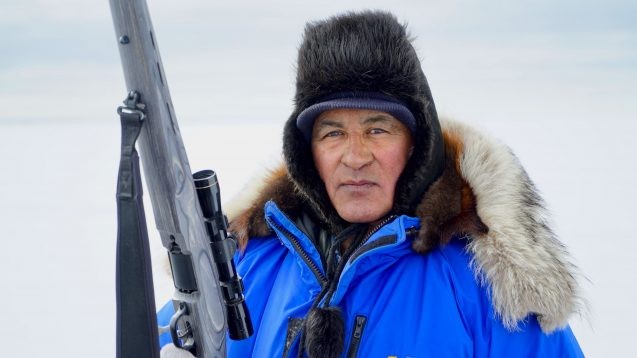Scientists and Native People Jointly Study Sea-Ice Declines Threatening Seal Hunts
Seals have been a staple for the coastal village of Kotzebue for generations. Rapid changes in sea ice driven by ocean warmth are presenting a challenge for hunters.
Climate change has severely reduced the length of the seal hunting season in a rural Alaska village, potentially threatening a key feature of the community’s way of life. Several new scientific studies, designed and carried out with members of the village, give a close-up look at exactly what is happening.
The Iñupiaq people of Kotzebue, on Alaska’s northwest coast, have depended on bearded seals, called ugruk in Iñupiaq, for food and clothing for generations. A new study led by Kotzebue residents and scientists from several institutions including Columbia University’s Lamont-Doherty Earth Observatory, shows that over the past 17 years, the seal hunting season has shrunk one day or more per year, and that seal habitat is shrinking. The study identifies the decline of sea ice as a major cause.
The research is part of the Ikaagvik Sikukun (Ice Bridges) project, which couples modern geophysical measurements with indigenous knowledge to answer research questions posed by the Kotzebue community. Two other papers from the project also recently published identify the vertical rise of heat from the ocean as the main driver of ice decline, with outflow from adjoining rivers contributing to both buildup and destruction of ice.
“The project is different from other current-day science research projects in that the hypotheses and research questions were co-developed with elders from the community,” said Christopher Zappa, a Lamont-Doherty oceanographer who helped lead the research. “Tighter clustering of seals due to sparse hunting conditions has policy implications for managing these subsistence resources sustainably.” Zappa said that the overall findings “point to the importance of co-production of knowledge with the indigenous communities who are impacted by climate change.”
Both ugruk and hunters are closely tied to specific sea ice conditions. In spring, ugruk follow the melting Chukchi Sea ice edge northward during breakup and enter Kotzebue Sound. Inside the sound, ugruk rest on persistent chunks of floating ice, called floes, while feeding on abundant fish, shrimp and clams.

Kotzebue Sound provides important spring habitat for bearded seals, with ice floes as platforms for seals to rest on between foraging bouts, said Donna Hauser, a marine mammal biologist at the University of Alaska Fairbanks and coleader of the research. “We learned from our Kotzebue research partners that hunting ugruk is actually like hunting the right kind of ice,” she said.
The study combined hunters’ knowledge of the ice conditions needed for ugruk hunting with data from satellite images. The results showed that the necessary ice floes now melt from the Kotzebue Sound roughly 22 days earlier than they did in 2003, the first year covered by the study.
“We used to hunt ugruk into July when I was growing up back in the 1950s,” said Robert Schaeffer, a Kotzebue elder, hunter and coauthor of the new paper. “People would be out there during Fourth of July celebration because there was so much ice. Now sometimes we’re done before June comes around.”
While the hunting season is pushed to a close earlier than in the past, hunters are not necessarily able to begin hunting any earlier. The season’s start timing is driven by the arrival of seals and hunters’ ability to launch boats through a channel in the ice that opens in front of Kotzebue. Squeezing the hunting season into a shorter window means that hunters have less flexibility.
“Now in some years there is only a good weekend or two, and, if people want to maximize their opportunity, they have to prepare before the season even starts,” said Alex Whiting, director of the Native Village of Kotzebue’s Environmental Program and co-leader of the research. Whiting’s weekly observations of local weather, ugruk activity and hunting pursuits of Kotzebue residents helped to quantify the shrinking hunting season.
Whiting said he was inspired to start a journal in 2002 after reading records of Alaska from the early 1900s. “When you’re living in the present, daily activities don’t seem particularly notable or remarkable,” he explained. “But I understood that they would be useful over time and that things were changing rapidly, and it would be great to have a record of it.”
Even with the shrinking season, Whiting’s records show that harvest success has not significantly changed. Instead, it is the hunting experience that has shifted. Past ice floes were large and complex, and hunters had to search long and far to find ugruk. Now, with less ice, hunters typically embark on shorter, more frequent trips. Ugruk seem to have changed their behavior, now often congregating in large groups on the scarce floes. Spring 2019 stood out to hunters and scientists because Kotzebue Sound was nearly devoid of ice. Hundreds of ugruk gathered on just a few floes near Kotzebue. As a result, hunting effort was low, but success was high.
The companion papers, which focus on the causes of ice decline, note that ice growth in the winters of 2017-18 and 2018-19 stopped unusually early due not only to a strong flux of heat from the ocean, but warm air temperatures, as measured by geophysical instruments anchored on and under the ice. The warmth also caused widespread surface flooding on the ice. This flooding likely had a negative impact on seal habitat.
Hunters worry that in future years, ugruk and ice floes may lie farther from Kotzebue across large expanses of open water, increasing the risk to boaters and lowering their chance of a successful hunt.
This research also included researchers from the University of Washington and Farthest North Films. Other Lamont-Doherty coauthors included Ajit Subramaniam, Nathan Laxague and Carson Witte. The research was funded by the Gordon and Betty Moore Foundation.
Adapted from a press release by the University of Alaska Fairbanks.
RELATED: Q&A WITH CHRISTOPHER ZAPPA
